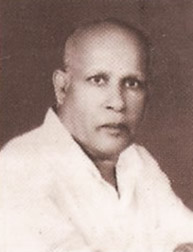Suddahami, scholar from Paliyagama
 One day a few years back I picked up a book titled Naga Gothrikayo at
the Godage bookshop. The author’s name was not familiar. When I saw the
address Paliyagama in Anamaduwa, and after reading the book, I wrote to
A Suddahami, that I wanted to meet him. That is how I came to know this
great man. One day a few years back I picked up a book titled Naga Gothrikayo at
the Godage bookshop. The author’s name was not familiar. When I saw the
address Paliyagama in Anamaduwa, and after reading the book, I wrote to
A Suddahami, that I wanted to meet him. That is how I came to know this
great man.
He was living in retirement in his home at Paliyagama, which is
several kilometers off the Anamaduwa Puttalam road. He reminded me of
the Village Elder of old times, who was the leader, counsellor and
benefactor. One instance where I saw his position in the village was at
an annual Deiyan Wendilla or the Hath Thattuwe Rajakariya held in early
April. This is a ritual where the entire village participates. Where the
evening meal prepared by the menfolk, is consumed by everyone in the
village, irrespective of their position in life. Suddahami explained
that this was an opportunity for all the people in the village to come
together, forget their differences or misunderstandings that may have
occurred during the year.
In Naga Gothrikayo he placed before us the efforts of all his search
in our chronicles about the tribe of Naga in our country. His second
publication was about Kuveni of the other tribe in Lanka, the Yaksha.
Kuveni has been much misunderstood and there also had been many
interpretations of her story. In Kuveni Nam Woo Yak Landa he reminds us
that Kuveni was a woman of flesh and blood like all of us, with human
feelings, hopes and desires, even though our ancient chronicles tried to
depict her as belonging to a tribe of cannibals. Sugath Samarakone is
now planning a film based on this book.
 |
|
Suddahami |
Suddahami’s latest book is Dahemi Kumaru Sirisanghabo, in which he is
once again trying to give us a clearer and more accurate picture of the
life and times of King Sirisanghabo, from his childhood in Mahiyangana,
life in Anuradhapura, his reign for two years, and to the last stage of
his life as a recluse. As he had done with his Nagas and Kuweni and
Dhatusena, he has checked and cross checked all our chronicles and
ancient inscriptions, to create this work. He has quoted often from Elu
Attanagalu Wanshaya.
Where did Sirisangabo die? Did he really cut off his head and hand it
over to the villager who shared his meal with the ex-king? According to
Hattawanagalla Vihara Wanshaya, Elu Attanagalu Wanshaya and Pujawaliya
the place is Attanagalle in the Gampaha district. However others like Dr
Godakumbara believed that it was at Hatthikuchchi in Rajangana in the
Anuradhapura district. Suddahami brings up the arguments for both sites
but tends to believe that this incident happened at Attanagalla.
There is also a very interesting reference to Leptospirosis,
(commonly known as rat fever). Pujawaliya and other books mention
Rakthakshi Maraka Jwara Rogaya as an epidemic which was caused by a
yaksha, and how king Sirisanghabo saved his countrymen by performing
Satyakriya and subduing the yaksha. Suddahami then quotes Prof Nimal
Senanayake, who recalls Prof Kumaradasa Jayasuriya mentioning in the
early 1970’s that the epidemic during Sirisanghabo’s time could have
been leptospirosis! Since the king had been able to chase the demon
away, we have to consider that leptospirosis had been eradicated during
the time of Sirisangabo.
Suddahami continues his good work. He has completed a book Demala
Hathpattuwa Woo Hathpattuwe Rata, the region where he was born, where he
was teaching, and where he lives today, tracing the history from the
earliest times. He is presently working on Demala Hathpattuwe Vanithava,
all about the women in the Hathpattuwa from the 18th century till the
early 20th century. Discussing their way of life, their dress, their
position in society.
Suddahami stands out among all present day writers because of his
courage and determination to overcome all the obstacles in his path.
Living in a remote village, many kilometers away from the small town of
Anamaduwa, limited in his travels due to his ailment, he has somehow
found the books for his reference, gathered information from his
colleagues and friends and scholars.
Sometimes his fingers are not completely under his control. He can
sign his name with difficulty, but he has managed to write and publish
four books. At his age, in his home at Paliyagama, Suddahami has
mastered the intricacies of the computer. He has managed to stroke the
keyboard with his stiff fingers, prepare his book and edit it all by
himself. Suddahami has shown us that official retirement is not the end
of life. He has shown how a person could contribute to his village and
to his country, sharing his knowledge and his thoughts with all of us.
[email protected]
|



